| |
Summary:
Comet 17P/Holmes shocked astronomers on Oct. 24, 2007, with a spectacular
eruption. In less than 24 hours, the 17th magnitude comet brightened
by a factor of nearly a million, becoming a naked-eye object in
the evening sky. By mid-November the expanding comet was the largest
object in the solar system--bigger even than the Sun. Since then,
the comet has faded back to invisibility. A leading model of the
blast posits a deep cavern of ice changing phase, from amorphous
to crystalline, releasing in transition enough heat to cause Holmes
to blow its top. The comet probably contains many such caverns so,
one day, it could happen again. [ephemeris]
[3D orbit] |
 |
| |
| |
Photographer,
Location |
Images |
Comments |
|

|
Sebastian
Voltmer,
Spicheren, France
Nov. 2, 2007 |
#1,
#2, more |
This is a composite image
of exploding Comet 17P/Holmes. German astrophotographer
Sebastian Voltmer combined various exposures taken through
his 4.1-inch refracting telescope and processed the composite
to highlight the comet's bright golden core (with jets and
streamers), its gossamer green halo and an emerging faint
blue tail. It's one of the strangest and most beautiful
photos of a comet ever. |
|

|
Wang
Wen Yih,
Baimen Tainan County, Taiwan
Oct. 28, 2007 |
#1 |
It's
a cloudy night, but just take it and got a dreamatic effect!
|
|

|
Andre
Paquette,
Ottawa, Ontario, Canada
Nov. 1, 2007 |
#1,
#2 |
Comet
Holmes in the UV wavelength shows both Cyanogen emission
and reflections from the sun in that narrow band. It is
also a useful way to improve the contrast against the background
stars to see more details on the outer areas of the comet.
These images were taken through a Celestron Onyx80EDF telescope
with a SBIG ST2000 camera and Baader 2" UV filter. Exposures
were 5x300s and guiding was done with MetaGuide. |
|

|
Dalibor Hanžl,
Bukovinka (near Brno), Czech Republic.
Nov. 1, 2007 |
#1,
more |
Comet 17P/Holmes located near the Mirphak (brigth star on the left). On the image are nebulas NGC 1491 and Sh-2-205 (to the right) and open cluster NGC 1528 (close to right margin),too. This is 48-min exposure (12x4 minute exp.) by Canon 20Da with 135mm camera lens at f/3.5 (ISO 1600 ASA).
|
|
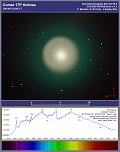
|
Paolo
Berardi and Giuseppe Di Carlo,
L'Aquila, Italy
Oct. 28, 2007 |
#1 |
It's
a ccd image and the spectrum of this comet. |
|

|
Lorenzo
Comolli,
Tradate, VA, Italy
Oct. 31, 2007 |
#1,
more |
Wide
field image with the autumn constellation, the Moon and
the comet 17P/Holmes, above my telescope observatory that
was imaging continuously the comet. Date and time: 31 nov
2007, 23.33 UT. |
|
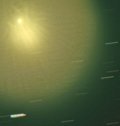
|
Chris Schur,
Payson, Arizona
Oct. 31, 2007 |
#1,
#2, more |
This is the deepest shot of any comet I have ever taken with my 12.5" newtonian. Clearly seen here are delicate internal rays comming from the nuclear regions, a bright jet and a brilliant sunshine yellow core. The outer green envelope recorded as a stunning emerald color. ST10XME, 120 minutes RGB
|
|

|
John Nassr,
Baguio, Philippines
Nov. 1, 2007 |
#1 |
This comet is large and growing even more!!
|
|

|
Patrick
Bornet,
Saint Martin sur Nohain, Nièvre, France
Oct. 31, 2007 |
#1,
#2, #3,
more |
These
photos show the comet and a double Iridium flare.
1st
photo: canon 350d with 18mm (29x180s 400iso) 2nd: 75mm 3rd:
LX90 (f=2000mm) comet's core |
|
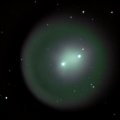
|
Tim
Caruk,
St John's, Newfoundland, Canada
Nov. 2, 2007 |
#1 |
Comet
Holmes is getting Huge. In this Nov2/07 image you can see
how the solar wind is forming the Coma. Rays of comet dust
seem to expand out from the core. I took the photo with
a 8 inch Celestron and an Olympus digital camera. |
|
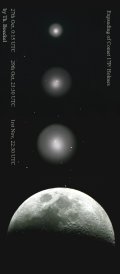
|
Thorsten Boeckel,
Fuerstenfeldbruck, Bavaria, South Germany
Nov. 1, 2007 |
#1,
#2, #3,
more |
The comet is growing and growing. My estimation is about 12 arcmin. I think on Sunday the comet has half moon diameter. Very good to see with the naked eye.
|
|
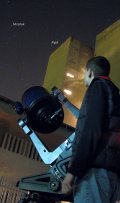
|
Valentin Grigore,
Targoviste, Romania
Oct. 30, 2007 |
#1,
#2, #3 |
Now the size and the brightness of the comet make it a veritable urban comet. The comet structure is visible just with the naked eyes. Also, it was visible in same photo field with Moon in conjunction with Mars. Just without a tail, this comet is a fantastic one!
|
|

|
Juan
Carlos Casado,
Sant Llorenç de la Muga, Girona, SPAIN
Nov. 1, 2007 |
#1,
more |
This
long exposure (1,200 seconds) was need to capture the faint
but well defined streamers of the comet Holmes. This negative
view aids to see better the tails at the left of the comet
in this image. Canon EOS 350D modified with a Nikkor IF-ED
300mm, f/2,8 lens plus a TC-301 2x teleconverter. |
|
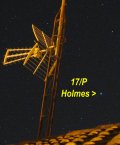
|
Fins
Eirexas,
Santiago de Compostela (Galiza-Spain)
Nov. 1, 2007 |
#1 |
Amazing
Comet 17/P Holmes and Iridium flare from Santiago de Compostela
(Galiza-Spain). Both shots were taken with a compact digital
camera (Canon PowersShot S400 4Mp)from my roof. Wide angle
has 15s exposure and close up shot (13s) was taken through
a 7X50 binoculars. |
|
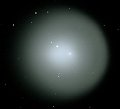
|
Ginger
Mayfield,
Divide, CO
Nov. 2, 2007 |
#1,
more |
The
comet continues to grow larger and larger each day. It looked
huge through my 14.5" Starmaster and a 12mm Nagler. I took
this image through the Starmaster with a Canon 30D. |
|
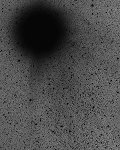
|
Mike
Holloway,
Van Buren, AR
Nov. 2, 2007 |
#1 |
This
is a 4x mosaic with each frame of the mosaic containing
15x40 second subframes. Turned negative to show the complex
tail structure |
|
|
|